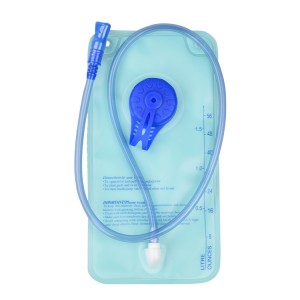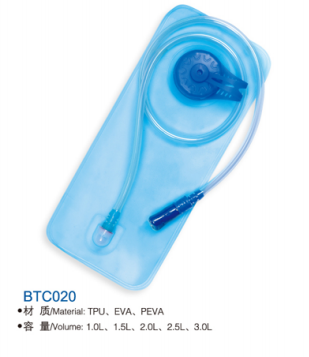When it comes to outdoor activities such as camping, hiking, or backpacking, having a reliable and durable water bladder is essential. These hydration systems allow adventurers to stay hydrated without having to carry bulky water bottles or constantly stop to refill. Two common materials used in making water bladders are TPU (Thermoplastic Polyurethane) and PEVA (Polyethylene Vinyl Acetate). Both TPU and PEVA have similar properties and are often used interchangeably, but which material is better for making a water bladder?
TPU and PEVA are two commonly used materials in various industries, and both have unique characteristics that make them suitable for different applications.
TPU (Thermoplastic Polyurethane) is a versatile material that is used in many applications, ranging from industrial and medical to consumer goods. It is a type of thermoplastic elastomer, which means it can be molded and shaped when heated and returns to its original shape when cooled. TPU is known for its high tensile strength, durability, and flexibility, making it a popular choice in the production of products such as sports equipment, phone cases, footwear, and medical devices.
On the other hand, PEVA (Polyethylene-vinyl acetate) is a type of non-chlorinated vinyl polymer that is commonly used as an alternative to PVC (polyvinyl chloride). It is softer and more flexible than PVC, making it an excellent choice for applications that require stretchability and resistance to water and chemicals. PEVA is commonly used in the packaging industry, as well as for shower curtains, raincoats, and medical and food-grade materials.
To determine which material is better, let’s take a closer look at the features and characteristics of TPU and PEVA.
Water Resistance
One of the main differences between TPU and PEVA is their water resistance. TPU has excellent resistance to water, making it a popular choice in the production of waterproof products like phone cases, outdoor gear, and medical equipment. It is also resistant to oils, grease, and abrasion, making it suitable for industrial and automotive applications.
PEVA, on the other hand, is also water-resistant, but it has a lower level of resistance compared to TPU. While it can repel water and moisture to a certain extent, it is not as effective as TPU in protecting products from harsh weather conditions.
Eco-Friendliness
In recent years, there has been a growing concern about the impact of plastic materials on the environment. Therefore, the eco-friendliness of a material has become an important consideration for both consumers and manufacturers.
In this aspect, PEVA may have an edge over TPU. PEVA is considered a more eco-friendly alternative to PVC due to its lack of chlorine and phthalates, which are harmful chemicals commonly found in PVC. It is also not known to release toxic fumes when incinerated, making it a more environmentally-friendly choice.
On the other hand, while TPU is not made of harmful chemicals, it is not biodegradable and takes a long time to decompose. This makes it less environmentally-friendly compared to PEVA. However, some manufacturers have started using renewable sources, such as plant-based materials, to produce TPU, making it a more sustainable option.
Durability
Both TPU and PEVA are known for their durability, but there are slight differences between the two. TPU has higher tensile strength and abrasion resistance, making it more durable and long-lasting compared to PEVA. This is why TPU is commonly used in high-stress applications such as sports equipment or industrial products. It can withstand repeated use and exposure to harsh environments without losing its properties.
PEVA, on the other hand, has a lower tensile strength and can be prone to tearing or puncturing in high-stress situations. However, it is still a durable material for its intended uses, such as shower curtains or food-grade packaging.
Flexibility
Both TPU and PEVA are flexible materials, but TPU offers more flexibility compared to PEVA. TPU is known for its high elongation capacity, which means it can stretch significantly without losing its shape or breaking. This makes it an ideal material for products that require flexibility, such as footwear, phone cases, or inflatable products.
PEVA, on the other hand, has a lower elongation capacity, which makes it less flexible than TPU. It can stretch to some extent, but it is not as flexible as TPU. This is why TPU is often the preferred material for applications that require a high level of flexibility.
Cost
Cost is another factor to consider when choosing between TPU and PEVA. TPU is more expensive compared to PEVA due to its higher quality, durability, and versatility. This makes it a preferred choice in industries that can afford the higher cost, such as sports and medical equipment.
On the other hand, PEVA is a more affordable option and is commonly used in industries that require large quantities of materials, such as packaging and consumer products. It is also a cost-effective choice for products that do not require high durability or flexibility.
Ease of Processing
When it comes to processing and handling, TPU and PEVA have some differences. As a thermoplastic material, TPU can be easily processed through methods such as injection molding, extrusion, or blow molding. This makes it a convenient choice for manufacturers who need to produce large quantities of products with complex shapes.
PEVA, on the other hand, has a lower melting point, which makes it more challenging to process. It requires special equipment and expertise to melt and mold, making it less convenient for large-scale production compared to TPU.
Both TPU and PEVA have their strengths and weaknesses when it comes to making water bladders. TPU is the more durable, flexible, and healthier option, while PEVA is more affordable and potentially more environmentally friendly with the production of biodegradable options.
FUJIAN SBS SIBO TECHNOLOGY CO.,LTD is a professional company that designs, develops, and sells outdoor products such as backpacks, water bags, fishing gear, etc. Our products are of high quality and reasonably priced. We provide flexible customization of materials, patterns, colors, weights, logos, packaging, and other accessories for all customers. We have our own automated production line for dust-free workshop water bottles, hydration tanks, and soft coolers, providing customers with more choices and diversified services.
We have our own R&D department to provide you with product customization services. There are also national level professional laboratories, and all products, including raw materials, have been tested. At the same time, it is equipped with a quality department, and the finished products are inspected by the quality department. All products of the company have passed the latest international environmental protection requirements of the country and the international European Union. Environmental certifications such as EN71, FDA, LFGB, BPA, 6P, PAHS, etc.
What is a TPU water bladder?
TPU water bladder is a flexible tank designed to store and transport various types of liquids, typically water. TPU stands for thermoplastic polyurethane, a strong and durable material that is commonly used in the production of water bladders due to its resistance to puncture, tear, and abrasion.
Is TPU water bottles safe?
TPU is safe and reliable. It’s 100% BPA and PVC free: every one of our products meets or exceeds the most rigorous national food safety standards in the world.
Post time: Mar-21-2024




